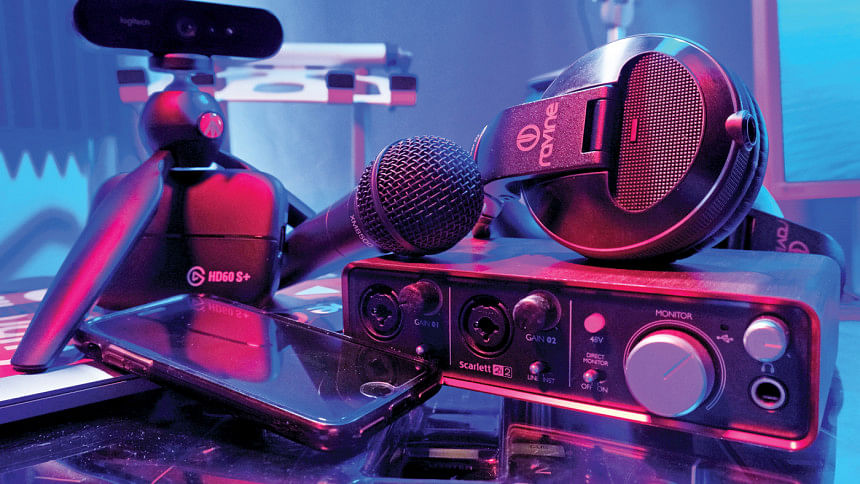Getting started with your own podcast: a complete build guide

What is a podcast anyway?
A Podcast is a series of spoken words, audio episodes, all focused on a particular topic or theme, like cycling, travel, or startups. One can subscribe to a podcast with an app whenever they want. Most podcasts today are audio-only, even though video podcasts do exist. Audio podcasts can be made visibly beautiful with the right artwork or design.
Why start your own?
If you are a content creator aspiring to reach a vast audience or just level up in blogging, you might want to choose podcasting. Podcasting has become the 21st century's most innovative content platform that harkens back to the ancient days of oral storytelling, but now to a mass audience with greater impact, your voice.
Podcasts are direct programs, undoubtedly varying from radio shows that offer deeper engagement and compared to blog content, it is a less crowded content channel. So, there are many advantages to starting a podcast of your own—new audiences, less competition, deeper impact, and greater intimacy among them. They can connect content creators with content consumers, and they can hardly be duplicated by other content mediums. And it takes less than you think to get started.
Building a podcast setup
A quality podcast will mean quality equipment. So, it is the gear to get started, which means assembling some equipment to create a quality podcast. You sure can start a podcast by scraping the bare minimum, your smartphone, but will end up ruining its quality.
The most essentials are a computer and a microphone, followed by a list of podcasting gear. You will have to choose from three kinds of mics. USBs are the easiest and used for solo podcasts for their direct plug-in and easier connectivity to your laptop or smartphones. If multiple people are involved, then Dynamic and Condenser mics with professional XLR connections are the way to go.
Next comes the audio interface (the bridge between microphone and computer), Mixer (to control levels, inputs, outputs and more), Pop Filter/Windscreen, Headphones (closed-back ones preferably to help prevent mistakes and retakes), Headphone Amplifier (in case you have several hosts), Mic stands (to position the microphone), Microphone cables (to plug the mic into the audio interface, mixer or preamp), acoustic panels (to minimise the echoes, if any). No reason to freak out, you can always leave one or two considering your budget if you plan accordingly.
Steps to creating a podcast
The steps for creating a functioning podcast ranges from building a setup to submitting it to the hosts and then directories. We have simplified the vast steps into four easy ones for creating a podcast.

Create a clear roadmap
Before getting into the actual production and technical part, figure out your content and format. Choose a quality and attractive topic and justify it with an adequate description and title. Your topic and content must be appealing to the audience and something you feel confident speaking about. Also, you must possess essential knowledge or expertise in that particular niche to market your podcast appropriately.
There are formats like interview style, current show events, guests, call-in, multi-host show, and solo styles to choose from. Also, you need to set a length and frequency for the podcast accordingly.
Record and edit the episode/audio file
For a podcast that sounds organised and professional, the key is to practice beforehand by outlining what you are going to say for your recording, as it is about the audio content. Each episode of your show will be a separate audio file that can be made available in various formats, MP3 files are generally recommended by professionals.
Editing is an essential part of the process to correct any mistake, smoothen and control voice levels, adding graphics, music, or artwork- and everything. Software like Audacity, GarageBand are free to use, Avid Pro Tools is for more professional ones, and requires an annual subscription.
Pick your podcast hosting provider
After you have finished recording, editing, and producing your podcast, you can upload it to hosting sites like BuzzSprout, PodBean or Transistor. They generate the required RSS feed for you. Some hosting sites also offer a free trial period and charge when you choose to go permanent.
Submit to directories
For every podcast episode you create, the host will provide a syndicated feed to platforms that play your podcast such as Spotify, SoundCloud, iTunes etc. For the promotion and sharing of your podcast, the sites play a vital role. Places like Soundcloud, for instance, offer a vigorous set of sharing options built-in. You can share directly to Twitter, Facebook, and more, and you can embed the audio directly into your blog posts.
Some pointers
Avoid some common mishaps by checking and rechecking your audio mixes thoroughly, using good mic technique and handling the gear tactfully. Checking everyone's headphone levels before you press record is important. Try to pick the quietest spot you can for your setup, or acoustic treatment to ensure minimum distortion.
The ideal length of a podcast is considered 20-22 minutes, varying content-wise with a weekly frequency, with a compatible and attractive name. Illustrious covers with enticing titles and artwork are more likely to attract your targeted audiences to tune in to your podcast and stick to it for more.
And there you go! Happy podcasting.

 For all latest news, follow The Daily Star's Google News channel.
For all latest news, follow The Daily Star's Google News channel. 



Comments